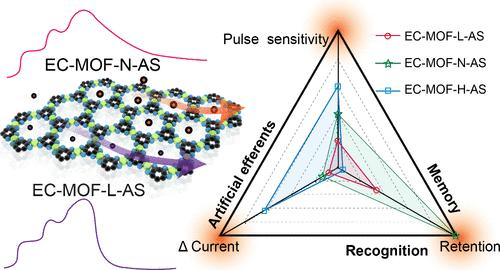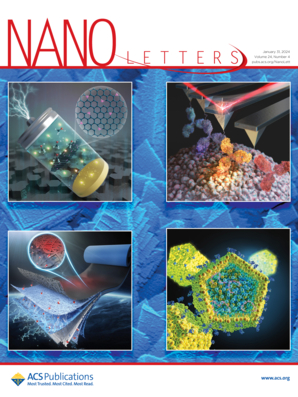Two-Dimensional Electrically Conductive Metal–Organic Framework Boosts Synaptic Plasticity for Dynamic Image Refresh, Classification, and Efferent Neuromuscular Systems
IF 9.6
1区 材料科学
Q1 CHEMISTRY, MULTIDISCIPLINARY
引用次数: 0
Abstract
We present a two-dimensional (2D) electrically conductive metal–organic framework (EC-MOF)-based artificial synapse. The intrinsic electronic conductivity and subnanometer channels of the EC-MOF facilitate efficient ion diffusion, enable a high density of active redox centers, and significantly enhance capacitance within the artificial synapse. As a result, the synapse operates at an ultralow voltage of 10 mV and exhibits a remarkably low power consumption of approximately 1 fW, along with the longest retention time recorded for two-terminal electrolyte-type artificial synapses to date. The alignment of the quantum size of the subnanometer pores in the EC-MOF with various cations allows for versatile synaptic plasticity. This capability is applied to image refresh, classification, and efferent signal transmission for controlling artificial muscles, thereby offering a methodology for achieving tunable neuromorphic properties. These findings suggest the potential application of metal–organic frameworks in artificial nervous systems for future brain-inspired computation, peripheral interfaces, and neurorobotics.

二维导电金属有机框架增强了动态图像刷新、分类和传出神经肌肉系统的突触可塑性
我们提出了一种基于二维导电金属有机框架(EC-MOF)的人工突触。EC-MOF 的固有电子导电性和亚纳米通道有助于离子的有效扩散,使活性氧化还原中心的密度很高,并显著增强了人工突触内的电容。因此,该突触可在 10 mV 的超低电压下工作,功耗极低(约 1 fW),并且具有迄今为止双端电解质型人工突触所记录的最长保持时间。EC-MOF 中亚纳米孔隙的量子尺寸与各种阳离子相匹配,可实现多种突触可塑性。这种能力被应用于图像刷新、分类和用于控制人造肌肉的传出信号传输,从而提供了一种实现可调神经形态特性的方法。这些发现表明,金属有机框架在人工神经系统中的潜在应用可用于未来的脑启发计算、外围接口和神经机器人。
本文章由计算机程序翻译,如有差异,请以英文原文为准。
求助全文
约1分钟内获得全文
求助全文
来源期刊

Nano Letters
工程技术-材料科学:综合
CiteScore
16.80
自引率
2.80%
发文量
1182
审稿时长
1.4 months
期刊介绍:
Nano Letters serves as a dynamic platform for promptly disseminating original results in fundamental, applied, and emerging research across all facets of nanoscience and nanotechnology. A pivotal criterion for inclusion within Nano Letters is the convergence of at least two different areas or disciplines, ensuring a rich interdisciplinary scope. The journal is dedicated to fostering exploration in diverse areas, including:
- Experimental and theoretical findings on physical, chemical, and biological phenomena at the nanoscale
- Synthesis, characterization, and processing of organic, inorganic, polymer, and hybrid nanomaterials through physical, chemical, and biological methodologies
- Modeling and simulation of synthetic, assembly, and interaction processes
- Realization of integrated nanostructures and nano-engineered devices exhibiting advanced performance
- Applications of nanoscale materials in living and environmental systems
Nano Letters is committed to advancing and showcasing groundbreaking research that intersects various domains, fostering innovation and collaboration in the ever-evolving field of nanoscience and nanotechnology.
 求助内容:
求助内容: 应助结果提醒方式:
应助结果提醒方式:


